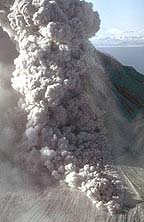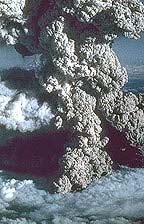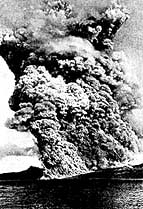
A pyroclastic flow is a fluidized mixture of solid to semi-solid fragments and hot, expanding gases that flows down the flank of a volcanic edifice. These awesome features are heavier-than-air emulsions that move much like a snow avalanche, except that they are fiercely hot, contain toxic gases, and move at phenomenal, hurricane-force speeds, often over 100 km/hour. They are the most deadly of all volcanic phenomena.

|

|
 |
|
Mt. Augustine (1996) |
Mt. St. Helens (1980) |
Mt. Pelée (1902) |
The extraordinary velocity of a pyroclastic flow is partly attributed to its fluidization. A moving pyroclastic flow has properties more like those of a liquid than a mass of solid fragments. Its fluid behavior can only be described as spectacular, as evidenced by the 6000-year-old Koya flow in southern Japan, which traveled more than 60 km from its source, ten of which were over open water! The Koya flow left a deposit that was only two meters thick over its 60 km extent. Such mobility comes from the disappearance of inter-particle friction. A fluidized flow is best described as a dispersion of large fragments in a medium of fluidized fine fragments. A constant stream of hot, expanding gases keeps the smallest of the fragments (ash and lapilli size particles) in constant suspension. This solid-gas mixture can then support larger fragments that float in the matrix. The expanding gas component is derived from a combination of (1) the constant exsolution of volcanic gas emitted by the hot pyroclasts, and (2) from the ingestion, heating, and rapid expansion air during movement of the flow.
The terminology of pyroclastic flows and pyroclastic flow deposits can be complex and confusing. In general, there are two end-member types of flows:
|
A nuée ardente deposit is called a block-and-ash deposit (see below), whereas a pumice flow deposit is called an ignimbrite. Each end-member type of pyroclastic flow is discussed below, followed by a description of ignimbrites.
The French geologist Alfred Lacroix attached the name nuée ardente (glowing cloud) to the pyroclastic flow from Mt. Pelée that destroyed the city of St. Pierre in 1902. The flow was generated from the explosive collapse of a growing lava dome at the summit of the volcano, which then swept down on the city. Thus, nuée ardente eruptions are often called Peléen eruptions. However, this term cannot be as narrowly defined as the other eruption types, because nuée ardentes are often linked with both Plinian and Vulcanian activity.
Although the term nuée ardente is now applied to all pyroclastic flows generated by dome collapse, it is somewhat of a misnomer to describe these features as a "glowing cloud." A more precise term would be glowing avalanche. The bulk of these hot block-and-ash flows hug the ground surface, but are disguised by an overlying cloud of fine ash particles that are winnowed out of the flow by a processes called elutriation. Nuée ardentes, therefore, are composed of two related parts: a pyroclastic avalanche largely hidden from view by an overlying ash cloud, sometimes called a co-ignimbrite ash.
|
Courtesy of B. Meyers, USGS |
Mt. Unzen nuée ardentes -- The diagram here demonstrates the sequence of events associated with the 1991-95 nuée ardente eruptions from Mt. Unzen, Japan. Collapse of a growing lava dome generates the nuée ardente. Within seconds a faster-moving cloud of smaller ash-sized fragments (the ash-cloud surge) forms above and in front of the nuée ardente. In some cases, dome collapse is attributed to explosive eruption at the summit crater. Explosive collapse may clear the throat of the volcano, thus generating vertical eruption columns. Over a four-year period, hundreds of nuée ardentes erupted from Mt. Unzen's summit area. Many of these swept down the populated Mizunashi River valley displacing thousands of people and destroying several hundred homes and precious farmland. |
Nuée ardente deposits are composed of dense, non-vesiculated, blocky fragments derived from the collapsed lava dome. They therefore differ significantly from the highly vesiculated ignimbrites which are derived from eruption column collapse. Nuée ardente deposits contain blocks in a fine-grained matrix of ash. The deposits, therefore, are called block-and-ash deposits. They are denser than ignimbrites, and typically are less extensive.
Pumice flows are pumice-rich pyroclastic flows derived from the collapse of an eruption column. The lowermost part of the eruption column is called the gas thrust region. Here, the density of the eruption column is greater than the density of the surrounding air. The column continues to rise, however, because of the thrust provided by the release and rapid expansion of volcanic gas. Occasionally, the gas thrust region may become so chock-full of debris that its high density cannot be supported by the thrust of expanding gases. The column thus collapses downward under gravity as a mass of vesiculating pumice that advances rapidly down the flanks of the volcano.
Although both nuée ardentes and pumice flows are fluidized, pumice flows are more energetic and mobile. This is partly attributed to their lower densities, but also to their greater store of kinetic energy generated by vertical drops up to several kilometers above the volcano's summit. The further it falls, the greater its kinetic energy, and the further and faster it will travel horizontally.
Pumice flows have a tripartite division. The main body hugs the ground surface and is dominated by pumice fragments in an ash matrix. Like nuée ardentes, this pyroclastic avalanche is overlain by an ash cloud of elutriated fine ash. An additional component of a pumice flow is the ground surge. These are forward-springing jets of incandescent ash that occur in the advancing head of the flow. They advance with a rolling and rapidly puffing movement which is thought to be caused by the ingestion of air in the front of the flow. Air ingestion produces strong fluidation in flow front, and explosive heating of the air causes some of the material to be hurled forward as a low-density, turbulent surge.
A single Plinian-type eruption may generate hundreds of pumice flows which typically flow down valleys radiating outward from the summit of the volcano. Individual flows may vary in length from a few kilometers to tens of kilometers. These are miniscule, however, in comparison to the massive pumice flows generated by caldera collapse. Caldera-generated flows are not restricted to valleys, but rather fill in valleys and adjacent low ridges to produce pumice-dominated pyroclastic sheet flows that can obliterate an area the size of Ohio in a few minutes. These huge eruptions can eject a thousand cubic kilometers of material from ring fractures in just a few hours. The last such eruption on earth took place at Toba, Indonesia, about 74,000 years ago to deposit an ignimbrite with a volume of over 2000 cubic kilometers. Similar eruptions in the United States occurred less than two million years ago at the Long Valley, Valles and Yellowstone calderas.
 Click this image to view a QuickTime
movie of a pyroclastic flow.
Click this image to view a QuickTime
movie of a pyroclastic flow.
Courtesy of the USGS.